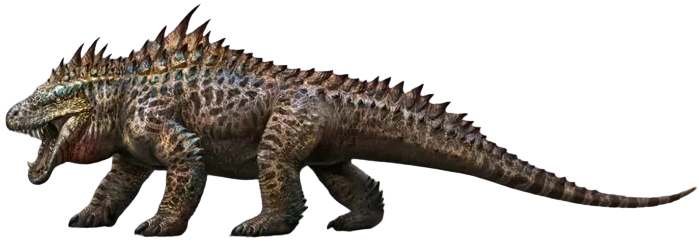Fasolasuchus Entity ID
Dossier
Wild
This wasteland’s full of surprises, and not exactly the good kind. There’s something out here that looks like Fasolasuchus, if those proto-crocs could swim through sand like water… These beasts might pop up suddenly to ambush you, or swim around you fast enough to catch you in a sand-whirlpool. I can't stress enough how dangerous this deathtrap can be! Plus their tails are strong enough to whip up sand to blind predators and prey alike. If you can help it, I recommend staying clear of those spikes. I think they’ve got acid glands at the base of their spiny fins, and in their mouths as well. Their caustic bite seems to melt through the thickest hide.
Domesticated
One of these monster sand-swimmers would make a great mount, but good luck slowing down something that can shrug off most narcotics. You could try softening one up with explosives, grabbing a spike, and steering it into a rock… But you’d have to be a bit mental to try. I imagine the adrenaline junkies able to tame a Fasolasuchus would earn themselves a formidable ride through these scorching sands. They seem to have adapted to fighting larger prey, so I'd advise any faso-rider to steer clear of packs of smaller creatures that can swarm over its defenses.
Real World Creature Description
Fasolasuchus: The Colossal Triassic Predator
The world of prehistoric creatures never ceases to amaze. Among the massive dinosaurs, flying pterosaurs, and monstrous marine reptiles, there exists another group of lesser-known but equally intriguing giants: the pseudosuchians. One of the most striking members of this group is the mighty Fasolasuchus.
What is Fasolasuchus?
Fasolasuchus tenax is an extinct genus of pseudosuchian, belonging to the group of reptiles known as rauisuchians. Despite its dinosaur-like appearance, it wasn’t a dinosaur. It lived during the Late Triassic period, approximately 230 million years ago, in what is now Argentina.
Size Matters
When we think of massive land predators, the iconic T. rex often comes to mind. However, Fasolasuchus, with its estimated length of about 10 meters (33 feet) or perhaps even longer, was one of the largest terrestrial predators of its time. It might even rival some of the better-known giant theropod dinosaurs in size.
Physical Features
Fasolasuchus bore a resemblance to modern-day crocodilians but on a much larger scale. It possessed a long snout filled with sharp teeth, indicating a carnivorous diet. Its limbs were robust and relatively straight, suggesting that it was a fully terrestrial creature unlike the sprawling ancestors of modern crocodiles.
Lifestyle and Environment
Fasolasuchus existed in a time when the first dinosaurs were just starting to appear. Given its size, it likely stood atop the food chain, preying on smaller reptiles, early dinosaurs, and other Triassic fauna. The environment of Late Triassic Argentina was semi-arid, dominated by rivers and vast floodplains, which would have provided an ample hunting ground for this colossal predator.
Taxonomy and Discovery
The sole species, Fasolasuchus tenax, was described in 1981 by Argentine paleontologist José F. Bonaparte. The fossils of Fasolasuchus, though not as complete as many researchers would like, provide essential insights into the evolution of giant predatory reptiles before the age of dominant dinosaurian predators.
Significance in Paleontology
The discovery of Fasolasuchus challenges the notion that giant theropod dinosaurs were the only massive land predators in Earth's history. It emphasizes the diversity of the Triassic ecosystems, where multiple large predatory archosaurs coexisted.
Furthermore, studying Fasolasuchus and other rauisuchians can shed light on the evolutionary pressures and environmental changes that eventually led to the rise and dominance of dinosaurs in the subsequent periods.
In Conclusion
Fasolasuchus is a testament to the myriad of creatures that have walked our planet. Its discovery not only adds another page to our understanding of Triassic ecosystems but also serves as a reminder of the ever-changing tapestry of life on Earth. With every new fossil unearthed, we get a glimpse into the incredible history of our planet and the awe-inspiring creatures that once roamed it.
Information

| Name | Fasolasuchus |
| Diet | Carnivore |
| Temperament | Aggressive |
| Category | Reptiles |
| DLC | Scorched Earth |
